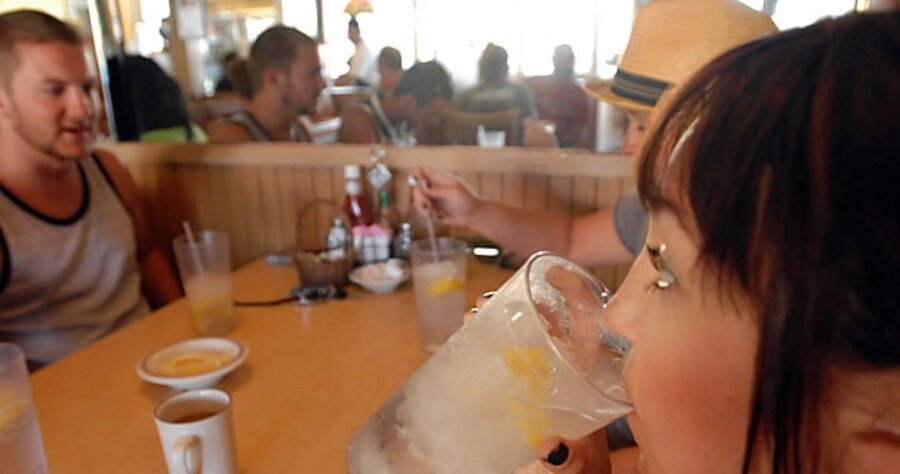Water’s odyssey from sewer to cup
Loading...
| Fountain Valley, Calif.
Tap water has never had so many fans. From neighboring states to distant countries, admirers have been traveling here to see – and drink – what’s coming from the faucets in thousands of southern California homes.
Orange County’s water utility has been drawing the gaze of engineers, scientists, and policymakers since it opened the world’s largest water recycling facility of its kind in January to scrub clean treated wastewater and turn it into drinking water.
Now, many of those admirers want to replicate Orange County’s model of replenishing freshwater supplies using purified sewer water. Los Angeles, San Jose, south Florida, and other locales are pursuing similar projects, which experts say are essential for coping with water scarcity likely to be associated with global warming.
“For much of the world, water reuse is going to become a fact of life. The Orange County project is a model for the world,” says William Cooper, director of the Urban Water Research Center at the University of California, Irvine. “When you have a precious resource like water, you have to do everything you can to protect it.”
The county’s $480 million Groundwater Replenishment System takes already-treated wastewater from the sanitation district next door and sends it through a rigorous three-step cleaning process. It’s washed through microfiltration, pressed through rows of reverse osmosis membranes, and then blasted with ultraviolet light and hydrogen peroxide. After 45 minutes, out comes clean, drinkable water.
The final product doesn’t go directly to the tap. Instead, half of it flows into a seawater barrier and the other half into a freshwater pond that replenishes the county’s groundwater basin. In the end, the recycled water makes up about 20 percent of the drinking water for roughly 2.3 million people.
It’s not necessarily the technology that has garnered Orange County such attention from water utilities around the globe. Recycling wastewater has been going on to lesser degrees elsewhere for some time. What has intrigued many is that the system met almost no public resistance when it came online in January.
“Technologically, it’s almost trivial for us to do this now. The key is to get public acceptance and political buy-in,” says Dr. Cooper, an early pioneer in water reuse practices.
And that was something Orange County worked hard to do from the beginning, spending $4 million in public outreach over 10 years. Water utility officials in Orange County had seen a similar plan squashed in San Diego when the recycling issue became politicized and the public turned away from the idea of turning toilet water into tap water.
“We talked to just about anyone who would listen to us,” says Michael Markus, general manager of the Orange County Water District, estimating that the county delivered about 700 speeches on its plans over a five-year period. “And it paid dividends because we had no opposition to the project.”
Orange County has long been out front in trying to reduce its long-term dependence on imported water from the Colorado River and northern California, the two water sources for dry and thirsty southern California. It launched Water Factory 21 in 1975, which, at the time, included the world’s largest reverse osmosis plant.
The county’s new recycling plant replaces Water Factory 21 and has the capacity to churn out 70 million gallons of purified water per day. Right now, it averages about 50 million gallons, essentially because its not getting enough water from the wastewater plant.
For it to produce more, says Mr. Markus, people need to flush more.
Even though the community has embraced the idea of adding recycled sewage into their drinking water supply, many still don’t realize the potential shortfalls the county could face as the population grows and rainfall decreases, says Markus.
“The process does not make up for not conserving water in other ways,” he says. “We live in a desert. [But] people take it for granted that we have all the water we need. That’s just not the case.”
While high-tech recycling efforts like this one have great potential in developed nations to reduce strains on natural resources, say experts, large-scale purification systems are out of reach for developing countries where water problems are severe and becoming worse.
That’s a problem that keeps Cooper awake nights. But, he says, just getting water to many of the world’s poorest would be a meaningful start, and using simple methods of cleaning, coupled with eduction, will help save lives.
On a recent weekday at the Fountain Valley, Markus, the general manager, strode past the rows of pipes and pumps that process the county’s new source of drinking water. At the end of the final stage – where the water is flashed with ultraviolet light – clear water flows from a faucet. He fills up a cups and takes a swig. “Tastes like water,” he says.
For the time being, regulators won’t allow the water district to deliver its recycled water directly to the tap. But it’s just a matter of time until that changes, Markus predicts.
“Like anything,” he says, “you need time to prove to the public that it’s the right thing to do.”
[Editor's note: The original version of a photo caption misidentified the location of a water treatment facility.]





